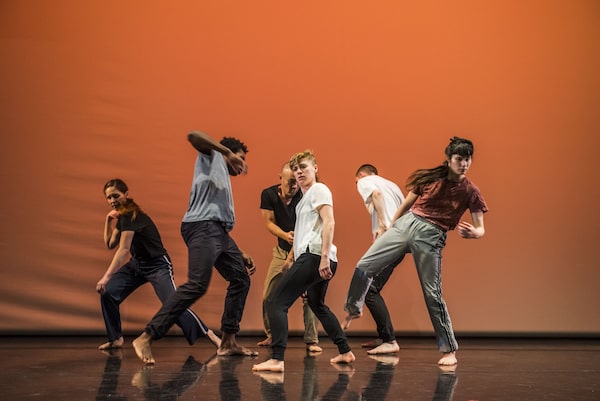
Alana Elmer, Devon Snell, Yuichiro Inoue, Valerie Calam, Peter Kelly and Margarita Soria in Mining Tracing.Omer K Yukseker
How do we toast the Toronto Dance Theatre (TDT) on its 50th birthday? On the Canadian dance landscape, its impact is almost too big to see in full. It’s no exaggeration to credit the company for introducing and propelling a culture of modern dance in the country.
In 1968, the “dance boom” was still exploding in New York, and the establishment of a Martha Graham-based company in Toronto by three local dancers (Patricia Beatty, David Earle and Peter Randazzo) was a driving event. Since then, TDT has been a nucleus in the city’s contemporary dance scene, evolving from a traditional Martha Graham-esque style to a company determined to present diverse voices, reflect changing trends in art and movement and invent a few of their own.
On Tuesday night at Toronto’s Fleck Dance Theatre, artistic director Christopher House took the stage in a tuxedo to introduce the anniversary program. For this landmark birthday, he asked four Canadian choreographers – Amanda Acorn, Jasmyn Fyffe, Hanna Kiel and Tedd Robinson – to reimagine his 1983 work Glass Houses using their own practice, vocabulary and ideas. He’s also responded to the work with his own reimagining, titled Thirteen, and rounded out the program, called Glass Fields, with a presentation of the original piece.

Christianne Ullmark, Pulga Muchochoma and Megumi Kokuba in Thirteen.Rich Blenkinsopp
I always find it interesting to see TDT remount their earlier work – it’s a reminder of how much the company’s dancers, and the dancing, has changed. When Glass Houses premiered and toured in the eighties, it was considered an example of American “minimalism.” (House had just returned from New York). Set against Toronto’s 2018 contemporary dance scene, it seems downright ornate.
Watching the original is a bit like downing a good glass of champagne – its effect is immediate, rousing and effervescent. It’s hard not to delight in some pure nostalgia: Lycra leotards, coloured waistbands and a high-energy score (Glass Houses No. 5 by Ann Southam). But what really stands out is the different quality of movement in comparison with TDT’s newer repertoire. There is pure technique here – spirals, sautés, grand battements with pointed toes, even the odd classical port de bras. It’s a reminder of how lucid and structured Graham and Limon technique can look and that, in the eighties and nineties, House wanted to create texture and dynamism with a more specific, formal vocabulary. Indeed, many of the company’s dancers of that era had strong classical foundations. Now, with less crossover between classical and contemporary worlds, the dancers are a bit uneven in their ability to rise to certain technical challenges.

Roberto Soria, Christianne Ullmark, Tia Kushniruk, Megumi Kokuba and Devon Snell in Glass Houses.Omer K Yukseker
Kiel’s G.H. 5.0 is an exciting work of choreography, the most captivating and physically ambitious response to the original. Dressing her dancers in more subdued, workaday pastels, Kiel distilled House’s energy and brightness, while adding complexity to the style and formations. She doesn’t cast away his graceful formalism so much as stretch and manipulate it. We get dancers slinking into conjoined lines, exploring lifts and layers, breaking off into solos and duets. Her musicality is astonishing at times and full of surprise, with sudden shifts in tempo that feel motivated by either the music itself (composed by Greg Harrison) or the tensions created by her own configurations. It’s also interesting to note how different G.H. 5.0 is from Kiel’s recent work – most notably, her hour-long Chasing the Path, which was narratively ambitious but perhaps worked too hard at externalizing internal experience.
Acorn might be the purest minimalist on the program. She’s a choreographer interested in the natural progression of a physical instinct, and is determined not to get in the way of where that instinct might go. In Mining Tracing, we see this approach applied to six bodies in white sneakers and shift dresses that reflect a bit of light (designed by Jennifer Dallas). Set to an electronic score by Jonathan Adjemian, the piece is a disciplined study of reaction and response – it’s meditative and vivid.
Fyffe cleverly inverts everything that’s bright and benevolent about the original and constructs an atmosphere that’s shadowy and menacing. Reset in Suits pulls a sequence of jumping turns from Glass Houses and has its four dancers reprise the sequence as an embodied storm. They appear in ongoing conflict with both themselves and their surroundings. Robinson’s 6 People Doing 6 Poses From 6 Photos to Music has dancers in coloured tube dresses find a compelling slowness and stillness – perhaps the space between the original steps – as its title suggests.

Pulga Muchochoma, Valerie Calam, Peter Kelly and Alana Elmer in 6 People Doing 6 Poses From 6 Photos to Music.Omer K Yukseker

Alana Elmer, Pulga Muchochoma and Tia Kushniruk in Reset in Suits.Omer K Yukseker
House’s Thirteen might be the most inscrutable in its relationship to Glass Houses. Using three dancers (Megumi Kokuba, Pulga Muchochoma, Christianne Ullmark) and loose choreography that relies on a sense of contingency and play, the piece is redolent of his 2014 Martingales. The dancers – Ullmark especially – are reactive and present, and as an audience we feel let in on something non-performative and improvised. But while Martingales succeeded as a kind of compelling community experiment, Thirteen never quite finds its conceptual voice. You can understand why a choreographer capable of the formal dynamism of Glass Houses might be interested, in his later career, in subduing, erasing, deconstructing. But with Thirteen, it all unwinds a bit too much.
Glass Fields continues at the Fleck Dance Theatre, Harbourfront Centre, until March 24.